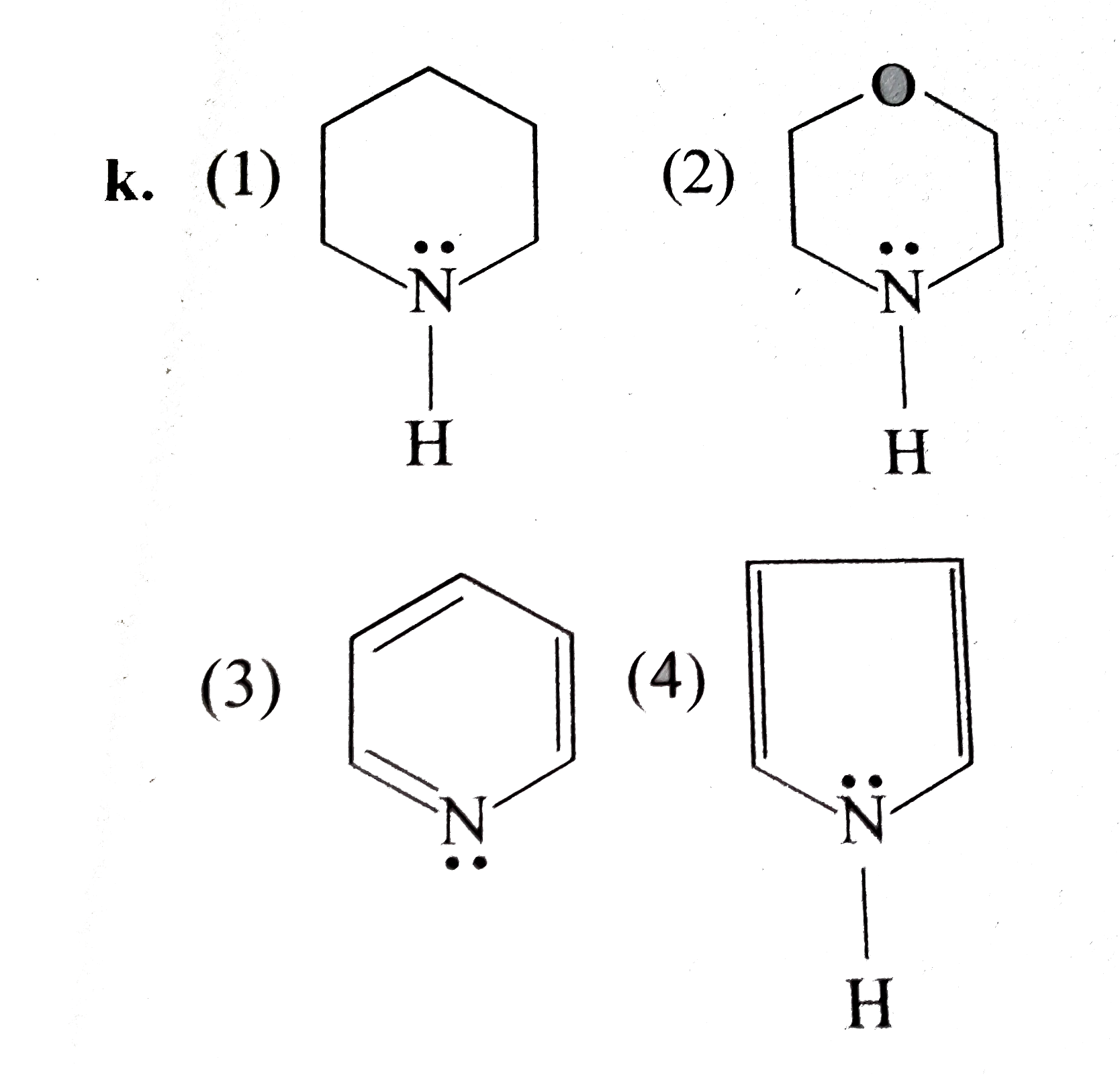[A]+[B]→C2H5NHCONHC2H5
(a)COCl2(b)ALCl3(c)C2H5NH2(d)CH2Br2
here , [A] & [B] are
a,b
b,c
c,d
a,c
The correct Answer is:D
To solve the problem, we need to identify compounds (A) and (B) that react to form the product C₂H₅NHCONHC₂H₅. The product is an amide, which suggests that one of the reactants must be an acyl chloride (or similar compound) and the other must be an amine.
1. Identify the Product Structure:
The product C₂H₅NHCONHC₂H₅ indicates that it contains an amide functional group (C=O attached to NH). The structure can be broken down as follows:
- C₂H₅NH- (ethylamine)
- CO (carbonyl group)
- NH (amide linkage)
- C₂H₅ (another ethyl group)
2. Determine the Reactants:
To form an amide, we typically need:
- An acyl chloride (which provides the carbonyl group)
- An amine (which provides the nitrogen)
3. Analyze the Given Options:
We have four options:
- (a) COCl₂ (which is an acyl chloride)
- (b) AlCl₃ (not relevant for amide formation)
- (c) C₂H₅NH₂ (which is ethylamine)
- (d) CH₂Br₂ (not relevant for amide formation)
4. Select the Correct Reactants:
- From the analysis, we can see that:
- (A) = COCl₂ (acyl chloride)
- (B) = C₂H₅NH₂ (ethylamine)
5. Reaction Mechanism:
The reaction proceeds as follows:
- The nitrogen in ethylamine (B) acts as a nucleophile and attacks the carbonyl carbon in the acyl chloride (A).
- This results in the formation of an intermediate where the chlorine atom leaves, leading to the formation of the amide C₂H₅NHCONHC₂H₅.
Conclusion:
Thus, the correct identification of (A) and (B) is:
- (A) = COCl₂
- (B) = C₂H₅NH₂
The product C₂H₅NHCONHC₂H₅ indicates that it contains an amide functional group (C=O attached to NH). The structure can be broken down as follows:
- C₂H₅NH- (ethylamine)
- CO (carbonyl group)
- NH (amide linkage)
- C₂H₅ (another ethyl group)
To form an amide, we typically need:
- An acyl chloride (which provides the carbonyl group)
- An amine (which provides the nitrogen)
We have four options:
- (a) COCl₂ (which is an acyl chloride)
- (b) AlCl₃ (not relevant for amide formation)
- (c) C₂H₅NH₂ (which is ethylamine)
- (d) CH₂Br₂ (not relevant for amide formation)
- From the analysis, we can see that:
- (A) = COCl₂ (acyl chloride)
- (B) = C₂H₅NH₂ (ethylamine)
The reaction proceeds as follows:
- The nitrogen in ethylamine (B) acts as a nucleophile and attacks the carbonyl carbon in the acyl chloride (A).
- This results in the formation of an intermediate where the chlorine atom leaves, leading to the formation of the amide C₂H₅NHCONHC₂H₅.
Thus, the correct identification of (A) and (B) is:
- (A) = COCl₂
- (B) = C₂H₅NH₂
Similar Questions
Complete the reaction :
C6H5−NH2+Br2(aq)→
View SolutionGive the decreasing order of acidic character.
(1) NO2CH2OH,
(b) C1CH2COOH,
(c) HCOOH,
(d) CH3COOH,
( e) CH3OH
(2) (a) RCOOH
(b) ROH
( c) H2O
(d) NH3
( e) CH≡CH
(f) RH
(3) (a) HCOOH
(b) PhOH
( c) CH3OH
(d) C2H5OH
( e)CH3C≡CH
(f) CH≡CH,
(g) NH3
(4) (a) CH3COOH
(b) H3O⊕
( c) H2O
(d) C2H5COOH
( e) NH3
(f) CH≡CH
(g) CH2=CH2
(h) CH4
(i) C2H6.
(5) (a) H2O
(b) CH3OH
( c) RC≡CH
(d) H2
( e) NH3
(f) RH
(g) ROH
(6) Basic character of conjugate base of Problem 5.
View Solution
Knowledge Check
C2H5−NH2+HNO2→A, A is :
AC2H5OHBC2H5NHOHCC2H6DC2H5NH2IUPAC name of C6H5−CH2−CH2−NH2
A2-phenyl ethanamideB2-phenyl ethanamineC2-phenyl ethylamineD3-phenyl ethanamineIf 'A' is C2H5NH2'B' is (C2H5)2NH,'C' is (C2H5)3N then order of solubility in water is
AA>B>CBB<A<CCC<B<ADC>B<A
Arrange the following :
C2H5NH2,C6H5NHCH3,(C2H5)2NHandC6H5NH2
(ii) In decreasing order of basic strength :
C6H5NH2,C6H5N(CH3)2,(C2H5)2NHandCH3NH2
(iii) Increasing order of basic strength :
(a) Aniline, p-nitroaniline and p-toluidine
(b) C6H5NH2,C6H5NHCH3,C6H5CH2NH2
(iv) Decreasing order of basic strength in gas phase :
C2H5NH2,(C2H5)NH,(C2H5)3NandNH3
(v) Increasing order of boiling point :
C2H5OH,(CH3)2NH,C2H5NH2
(vi) Increasing order of solubility in water :
C6H5NH2,(C2H5)2NH,C2H5NH2
View SolutionArrange the following in the increasing order of basicity.
C6H5NH2,C6H5N(CH3)2,(C2H5)2NH,CH3NH2.
View SolutionComlete the following reactions :
i.C2H5NH2+CHCl3+Alc.KOH→
ii. C6H5N2Cl+H3H3PO2+H2O→
iii. C6H5NH4+H2SO4(Conc.)→
iv. C6H5H2cl+C−H5OH→
v. C6H5NH2Cl+C2H5OH→
vi. C6H5NH2+Br2(Aq.)→.
vii C6H5N2Cl(i)HBF4−−−−−−−−−−−−→(ii)NaNO2/Cu,Δ
View SolutionArrange the following in the order of decreasing basic character :
(a) (1) CH3NH2
(2) (CH3)2NH
(3) C6H5NH2
NH3
(b) (1) CH3NH2
(2) (CH3)2NH
(3) CH3)3N
(4) C6H5NH2
( c) (1) NH3
(2) CH3NH2
(3) C6H5NH2
(4) (C6H5)2NH
(5) (C6H5)3N
(d) (1) C6H5NH2
(2) p−NO2C6H4NH2
(3) m−NO2C6H4NH2
(4) p−CH3OC6H4NH2
( e) (1) p−Toluidine
(2) N,N−Dimethy1-p-toluidine
(3) p−Nitroaniline
(4) Aniline
(f) (1) Methulamine
(2) Dimethylamine
(3) Aniline
(4) N−Methylaniline
(g) (1) RCN
(2) RNH2
(3) RN=CHR
(h) (1) C2H5NH2
(2) (iso−C3H7)3N
(3) CH3CONH2
(4) CH3ӨNHNa⊕
(i) (1) ӨNH2
(2) HC≡CӨ
(3) .ӨOH
(4) .ӨOR
(5) RӨ
(6) RCOOӨ
(j) (1) HӨ
(2) C1Ө
(3) NHӨ2
(4) RCOOӨ
(5) ROӨ
 .
.
View SolutionArrange the following :
(i) IN increasing order of basic strength :
C6H5NH2,C6H5NH−CH3,C6H5−CH2−NH2
(ii) In increasing order of boiling point :
C4H9−NH2,(C2H5)2NH,C2H5N(CH3)2
View Solution
